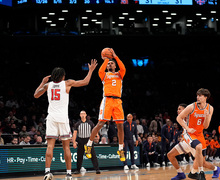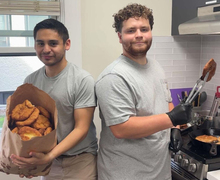Sci Tech: SU sees increase in use of buses, green transportation
Eco-friendly transportation is on the rise on the Syracuse University campus, according to data collected by SU Parking and Transit Services over the past two years.
Centro bus service and Parking and Transit Services are seeing an increase in the number of campus community members riding buses and registering for Zipcars. The department is also beginning to collect data on campus bike use.
The number of bus riders on campus has increased from 2 million in the 2008 fiscal year to 2.2 million in the 2009 fiscal year, said Steven Koegel, director for marketing and communications for Centro.
“We anticipate a slight increase in 2010 as well,” he said.
Bus routes included in these statistics include the South, North and East campus buses, the Carousel Center bus route and Connective Corridor bus.
Centro buses are made to be eco-friendly. Currently, of a fleet of 150 buses, 120 are run on compressed natural gas with no carbon emissions, nine are diesel-electric hybrids and the rest are run on clean diesel with a bio-diesel component, Koegel said.
Outside of SU bus routes, Centro rider numbers have decreased by 4 to 5 percent since last year. This is due to gas prices coming down in 2008 and then leveling off, Koegel said. The peak of overall ridership occurred when gas prices hit their height of about $4 in summer 2008.
“People save a lot of money. Someone driving a car usually is paying a car payment, paying for gas and insurance,” he said. “When you total that all together, sometimes with repair payments they’re paying $500 to $800 a month. With a Centro bus pass, it’s $50 per month.”
SU students can benefit from buses because the routes they ride are free, said Rick Martin, SU’s principal sustainability analyst, in an e-mail. This is cheaper than paying up to almost $1 per mile on gas for a car, he said.
“City bus fuel consumption isn’t really affected by the number of passengers on board, while the amount of gasoline your car uses is very much affected by whether or not you drive it,” he said.
Centro shares its user information with Parking and Transit Services to better manage the campus bus system, said Scot Vanderpool, the director of Parking and Transit Services, in an e-mail.
At the beginning of the year, Parking and Transit Services closely tracked Centro and added trips in areas where there were greater volumes of passengers, Vanderpool said.
“Due to statistics we had gathered, we were able to add two buses between 9 and 10 p.m. to take care of overloads on College Place,” he said.
In addition to the spike in bus passengers from SU, there has also been an increase in the use of Zipcars, a car-sharing program.
The Zipcar program began with two vehicles in 2008 as a result of extensive research into Zipcar programs at other universities. SU wanted to offer another transportation option to students, faculty and staff, Vanderpool said.
“We saw a need for people who walked, biked, used public transportation to have an option or a fallback, if needed,” he said.
In addition to the eco-friendly practice of sharing cars, the cars themselves are energy-efficient. The SU Zipcars include two hybrids and two four-cylinder, fuel-efficient vehicles.
In order to keep up with demand, the program added three more vehicles in the fall of 2009, Vanderpool said.
Currently, there are 325 students registered in the program, as well as 28 faculty and staff members and four campus departments, Vanderpool said.
“The response has been tremendous,” he said. “In fact, we are talking about expanding again and adding another vehicle for the start of the fall semester 2010.”
In addition to tracking Centro and Zipcars, Parking and Transit Services is in the process of collecting data on campus bicycle use.
Last year, the department surveyed bikes on the Quad at 11:30 a.m. on a Thursday and found that there were 236 bikes, a high number, Vanderpool said.
“We will be surveying bikes on campus again this year to get a gauge on the trends,” he said. “The numbers from last year are very encouraging.”
Published on March 30, 2010 at 12:00 pm





